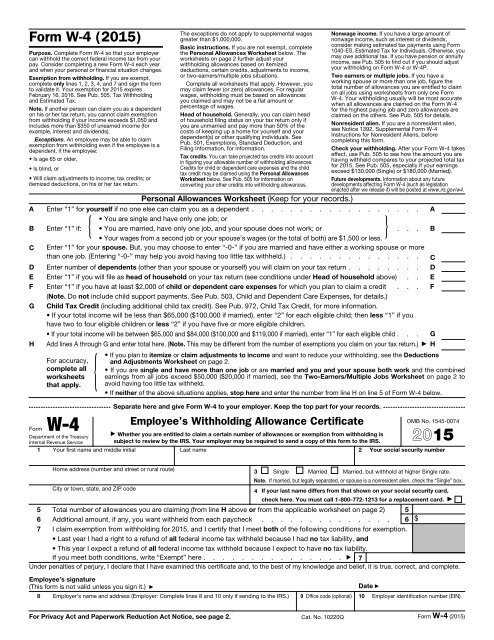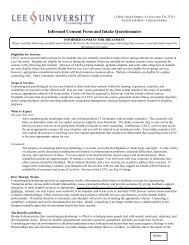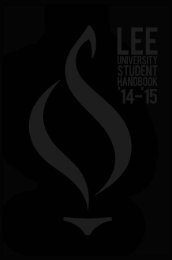2013 Form W-4 - Lee University
2013 Form W-4 - Lee University
2013 Form W-4 - Lee University
You also want an ePaper? Increase the reach of your titles
YUMPU automatically turns print PDFs into web optimized ePapers that Google loves.
<strong>Form</strong> W-4 (2015)<br />
Purpose. Complete <strong>Form</strong> W-4 so that your employer<br />
can withhold the correct federal income tax from your<br />
pay. Consider completing a new <strong>Form</strong> W-4 each year<br />
and when your personal or financial situation changes.<br />
Exemption from withholding. If you are exempt,<br />
complete only lines 1, 2, 3, 4, and 7 and sign the form<br />
to validate it. Your exemption for 2015 expires<br />
February 16, 2016. See Pub. 505, Tax Withholding<br />
and Estimated Tax.<br />
Note. If another person can claim you as a dependent<br />
on his or her tax return, you cannot claim exemption<br />
from withholding if your income exceeds $1,050 and<br />
includes more than $350 of unearned income (for<br />
example, interest and dividends).<br />
Exceptions. An employee may be able to claim<br />
exemption from withholding even if the employee is a<br />
dependent, if the employee:<br />
• Is age 65 or older,<br />
• Is blind, or<br />
• Will claim adjustments to income; tax credits; or<br />
itemized deductions, on his or her tax return.<br />
The exceptions do not apply to supplemental wages<br />
greater than $1,000,000.<br />
Basic instructions. If you are not exempt, complete<br />
the Personal Allowances Worksheet below. The<br />
worksheets on page 2 further adjust your<br />
withholding allowances based on itemized<br />
deductions, certain credits, adjustments to income,<br />
or two-earners/multiple jobs situations.<br />
Complete all worksheets that apply. However, you<br />
may claim fewer (or zero) allowances. For regular<br />
wages, withholding must be based on allowances<br />
you claimed and may not be a flat amount or<br />
percentage of wages.<br />
Head of household. Generally, you can claim head<br />
of household filing status on your tax return only if<br />
you are unmarried and pay more than 50% of the<br />
costs of keeping up a home for yourself and your<br />
dependent(s) or other qualifying individuals. See<br />
Pub. 501, Exemptions, Standard Deduction, and<br />
Filing Information, for information.<br />
Tax credits. You can take projected tax credits into account<br />
in figuring your allowable number of withholding allowances.<br />
Credits for child or dependent care expenses and the child<br />
tax credit may be claimed using the Personal Allowances<br />
Worksheet below. See Pub. 505 for information on<br />
converting your other credits into withholding allowances.<br />
Nonwage income. If you have a large amount of<br />
nonwage income, such as interest or dividends,<br />
consider making estimated tax payments using <strong>Form</strong><br />
1040-ES, Estimated Tax for Individuals. Otherwise, you<br />
may owe additional tax. If you have pension or annuity<br />
income, see Pub. 505 to find out if you should adjust<br />
your withholding on <strong>Form</strong> W-4 or W-4P.<br />
Two earners or multiple jobs. If you have a<br />
working spouse or more than one job, figure the<br />
total number of allowances you are entitled to claim<br />
on all jobs using worksheets from only one <strong>Form</strong><br />
W-4. Your withholding usually will be most accurate<br />
when all allowances are claimed on the <strong>Form</strong> W-4<br />
for the highest paying job and zero allowances are<br />
claimed on the others. See Pub. 505 for details.<br />
Nonresident alien. If you are a nonresident alien,<br />
see Notice 1392, Supplemental <strong>Form</strong> W-4<br />
Instructions for Nonresident Aliens, before<br />
completing this form.<br />
Check your withholding. After your <strong>Form</strong> W-4 takes<br />
effect, use Pub. 505 to see how the amount you are<br />
having withheld compares to your projected total tax<br />
for 2015. See Pub. 505, especially if your earnings<br />
exceed $130,000 (Single) or $180,000 (Married).<br />
Future developments. Information about any future<br />
developments affecting <strong>Form</strong> W-4 (such as legislation<br />
enacted after we release it) will be posted at www.irs.gov/w4.<br />
Personal Allowances Worksheet (Keep for your records.)<br />
A Enter “1” for yourself if no one else can claim you as a dependent . . . . . . . . . . . . . . . . . . A<br />
• You are single and have only one job; or<br />
B Enter “1” if:<br />
{ • You are married, have only one job, and your spouse does not work; or . . . B<br />
• Your wages from a second job or your spouse’s wages (or the total of both) are $1,500 or less.<br />
C Enter “1” for your spouse. But, you may choose to enter “-0-” if you are married and have either a working spouse or more<br />
than one job. (Entering “-0-” may help you avoid having too little tax withheld.) . . . . . . . . . . . . . . C<br />
D Enter number of dependents (other than your spouse or yourself) you will claim on your tax return . . . . . . . . D<br />
E Enter “1” if you will file as head of household on your tax return (see conditions under Head of household above) . . E<br />
F Enter “1” if you have at least $2,000 of child or dependent care expenses for which you plan to claim a credit . . . F<br />
(Note. Do not include child support payments. See Pub. 503, Child and Dependent Care Expenses, for details.)<br />
G Child Tax Credit (including additional child tax credit). See Pub. 972, Child Tax Credit, for more information.<br />
• If your total income will be less than $65,000 ($100,000 if married), enter “2” for each eligible child; then less “1” if you<br />
have two to four eligible children or less “2” if you have five or more eligible children.<br />
• If your total income will be between $65,000 and $84,000 ($100,000 and $119,000 if married), enter “1” for each eligible child . . . G<br />
H Add lines A through G and enter total here. (Note. This may be different from the number of exemptions you claim on your tax return.) ▶ H<br />
{<br />
• If you plan to itemize or claim adjustments to income and want to reduce your withholding, see the Deductions<br />
For accuracy, and Adjustments Worksheet on page 2.<br />
complete all • If you are single and have more than one job or are married and you and your spouse both work and the combined<br />
worksheets earnings from all jobs exceed $50,000 ($20,000 if married), see the Two-Earners/Multiple Jobs Worksheet on page 2 to<br />
that apply. avoid having too little tax withheld.<br />
• If neither of the above situations applies, stop here and enter the number from line H on line 5 of <strong>Form</strong> W-4 below.<br />
Separate here and give <strong>Form</strong> W-4 to your employer. Keep the top part for your records.<br />
Employee's Withholding Allowance Certificate<br />
<strong>Form</strong> W-4<br />
▶<br />
Department of the Treasury<br />
Whether you are entitled to claim a certain number of allowances or exemption from withholding is<br />
Internal Revenue Service<br />
subject to review by the IRS. Your employer may be required to send a copy of this form to the IRS.<br />
1 Your first name and middle initial Last name<br />
OMB No. 1545-0074<br />
2015<br />
2 Your social security number<br />
Home address (number and street or rural route)<br />
3 Single Married Married, but withhold at higher Single rate.<br />
Note. If married, but legally separated, or spouse is a nonresident alien, check the “Single” box.<br />
City or town, state, and ZIP code<br />
4 If your last name differs from that shown on your social security card,<br />
check here. You must call 1-800-772-1213 for a replacement card. ▶<br />
5 Total number of allowances you are claiming (from line H above or from the applicable worksheet on page 2) 5<br />
6 Additional amount, if any, you want withheld from each paycheck . . . . . . . . . . . . . . 6 $<br />
7 I claim exemption from withholding for 2015, and I certify that I meet both of the following conditions for exemption.<br />
• Last year I had a right to a refund of all federal income tax withheld because I had no tax liability, and<br />
• This year I expect a refund of all federal income tax withheld because I expect to have no tax liability.<br />
If you meet both conditions, write “Exempt” here . . . . . . . . . . . . . . . ▶ 7<br />
Under penalties of perjury, I declare that I have examined this certificate and, to the best of my knowledge and belief, it is true, correct, and complete.<br />
Employee’s signature<br />
(This form is not valid unless you sign it.) ▶<br />
Date ▶<br />
8 Employer’s name and address (Employer: Complete lines 8 and 10 only if sending to the IRS.) 9 Office code (optional) 10 Employer identification number (EIN)<br />
For Privacy Act and Paperwork Reduction Act Notice, see page 2. Cat. No. 10220Q <strong>Form</strong> W-4 (2015)
<strong>Form</strong> W-4 (2015) Page 2<br />
Deductions and Adjustments Worksheet<br />
Note. Use this worksheet only if you plan to itemize deductions or claim certain credits or adjustments to income.<br />
1 Enter an estimate of your 2015 itemized deductions. These include qualifying home mortgage interest, charitable contributions, state<br />
and local taxes, medical expenses in excess of 10% (7.5% if either you or your spouse was born before January 2, 1951) of your<br />
income, and miscellaneous deductions. For 2015, you may have to reduce your itemized deductions if your income is over $309,900<br />
and you are married filing jointly or are a qualifying widow(er); $284,050 if you are head of household; $258,250 if you are single and not<br />
head of household or a qualifying widow(er); or $154,950 if you are married filing separately. See Pub. 505 for details . . . . 1 $<br />
$12,600 if married filing jointly or qualifying widow(er)<br />
2 Enter:<br />
{<br />
$9,250 if head of household<br />
}<br />
. . . . . . . . . . . 2 $<br />
$6,300 if single or married filing separately<br />
3 Subtract line 2 from line 1. If zero or less, enter “-0-” . . . . . . . . . . . . . . . . 3 $<br />
4 Enter an estimate of your 2015 adjustments to income and any additional standard deduction (see Pub. 505) 4 $<br />
5 Add lines 3 and 4 and enter the total. (Include any amount for credits from the Converting Credits to<br />
Withholding Allowances for 2015 <strong>Form</strong> W-4 worksheet in Pub. 505.) . . . . . . . . . . . . 5 $<br />
6 Enter an estimate of your 2015 nonwage income (such as dividends or interest) . . . . . . . . 6 $<br />
7 Subtract line 6 from line 5. If zero or less, enter “-0-” . . . . . . . . . . . . . . . . 7 $<br />
8 Divide the amount on line 7 by $4,000 and enter the result here. Drop any fraction . . . . . . . 8<br />
9 Enter the number from the Personal Allowances Worksheet, line H, page 1 . . . . . . . . . 9<br />
10 Add lines 8 and 9 and enter the total here. If you plan to use the Two-Earners/Multiple Jobs Worksheet,<br />
also enter this total on line 1 below. Otherwise, stop here and enter this total on <strong>Form</strong> W-4, line 5, page 1 10<br />
Two-Earners/Multiple Jobs Worksheet (See Two earners or multiple jobs on page 1.)<br />
Note. Use this worksheet only if the instructions under line H on page 1 direct you here.<br />
1 Enter the number from line H, page 1 (or from line 10 above if you used the Deductions and Adjustments Worksheet) 1<br />
2 Find the number in Table 1 below that applies to the LOWEST paying job and enter it here. However, if<br />
you are married filing jointly and wages from the highest paying job are $65,000 or less, do not enter more<br />
than “3” . . . . . . . . . . . . . . . . . . . . . . . . . . . . . . 2<br />
3 If line 1 is more than or equal to line 2, subtract line 2 from line 1. Enter the result here (if zero, enter<br />
“-0-”) and on <strong>Form</strong> W-4, line 5, page 1. Do not use the rest of this worksheet . . . . . . . . . 3<br />
Note. If line 1 is less than line 2, enter “-0-” on <strong>Form</strong> W-4, line 5, page 1. Complete lines 4 through 9 below to<br />
figure the additional withholding amount necessary to avoid a year-end tax bill.<br />
4 Enter the number from line 2 of this worksheet . . . . . . . . . . 4<br />
5 Enter the number from line 1 of this worksheet . . . . . . . . . . 5<br />
6 Subtract line 5 from line 4 . . . . . . . . . . . . . . . . . . . . . . . . . 6<br />
7 Find the amount in Table 2 below that applies to the HIGHEST paying job and enter it here . . . . 7 $<br />
8 Multiply line 7 by line 6 and enter the result here. This is the additional annual withholding needed . . 8 $<br />
9 Divide line 8 by the number of pay periods remaining in 2015. For example, divide by 25 if you are paid every two<br />
weeks and you complete this form on a date in January when there are 25 pay periods remaining in 2015. Enter<br />
the result here and on <strong>Form</strong> W-4, line 6, page 1. This is the additional amount to be withheld from each paycheck 9 $<br />
Table 1<br />
Table 2<br />
Married Filing Jointly<br />
All Others<br />
Married Filing Jointly<br />
All Others<br />
If wages from LOWEST<br />
paying job are—<br />
Enter on<br />
line 2 above<br />
$0 - $6,000 0<br />
6,001 - 13,000 1<br />
13,001 - 24,000 2<br />
24,001 - 26,000 3<br />
26,001 - 34,000 4<br />
34,001 - 44,000 5<br />
44,001 - 50,000 6<br />
50,001 - 65,000 7<br />
65,001 - 75,000 8<br />
75,001 - 80,000 9<br />
80,001 - 100,000 10<br />
100,001 - 115,000 11<br />
115,001 - 130,000 12<br />
130,001 - 140,000 13<br />
140,001 - 150,000 14<br />
150,001 and over 15<br />
If wages from LOWEST<br />
paying job are—<br />
Enter on<br />
line 2 above<br />
$0 - $8,000 0<br />
8,001 - 17,000 1<br />
17,001 - 26,000 2<br />
26,001 - 34,000 3<br />
34,001 - 44,000 4<br />
44,001 - 75,000 5<br />
75,001 - 85,000 6<br />
85,001 - 110,000 7<br />
110,001 - 125,000 8<br />
125,001 - 140,000 9<br />
140,001 and over 10<br />
Privacy Act and Paperwork Reduction Act Notice. We ask for the information on this<br />
form to carry out the Internal Revenue laws of the United States. Internal Revenue Code<br />
sections 3402(f)(2) and 6109 and their regulations require you to provide this information; your<br />
employer uses it to determine your federal income tax withholding. Failure to provide a<br />
properly completed form will result in your being treated as a single person who claims no<br />
withholding allowances; providing fraudulent information may subject you to penalties. Routine<br />
uses of this information include giving it to the Department of Justice for civil and criminal<br />
litigation; to cities, states, the District of Columbia, and U.S. commonwealths and possessions<br />
for use in administering their tax laws; and to the Department of Health and Human Services<br />
for use in the National Directory of New Hires. We may also disclose this information to other<br />
countries under a tax treaty, to federal and state agencies to enforce federal nontax criminal<br />
laws, or to federal law enforcement and intelligence agencies to combat terrorism.<br />
If wages from HIGHEST<br />
paying job are—<br />
Enter on<br />
line 7 above<br />
$0 - $75,000 $600<br />
75,001 - 135,000 1,000<br />
135,001 - 205,000 1,120<br />
205,001 - 360,000 1,320<br />
360,001 - 405,000 1,400<br />
405,001 and over 1,580<br />
If wages from HIGHEST<br />
paying job are—<br />
Enter on<br />
line 7 above<br />
$0 - $38,000 $600<br />
38,001 - 83,000 1,000<br />
83,001 - 180,000 1,120<br />
180,001 - 395,000 1,320<br />
395,001 and over 1,580<br />
You are not required to provide the information requested on a form that is subject to the<br />
Paperwork Reduction Act unless the form displays a valid OMB control number. Books or<br />
records relating to a form or its instructions must be retained as long as their contents may<br />
become material in the administration of any Internal Revenue law. Generally, tax returns and<br />
return information are confidential, as required by Code section 6103.<br />
The average time and expenses required to complete and file this form will vary depending<br />
on individual circumstances. For estimated averages, see the instructions for your income tax<br />
return.<br />
If you have suggestions for making this form simpler, we would be happy to hear from you.<br />
See the instructions for your income tax return.
















